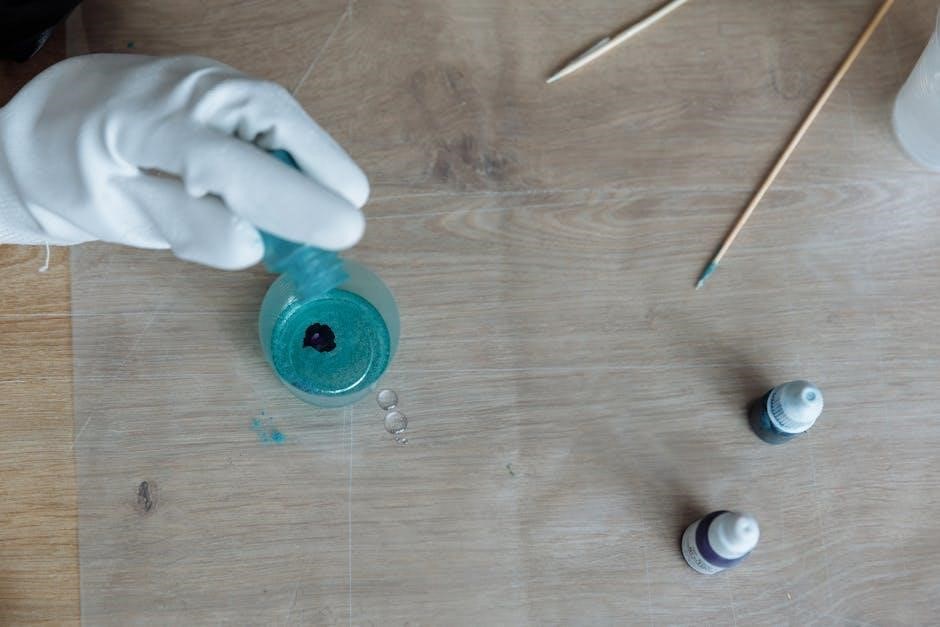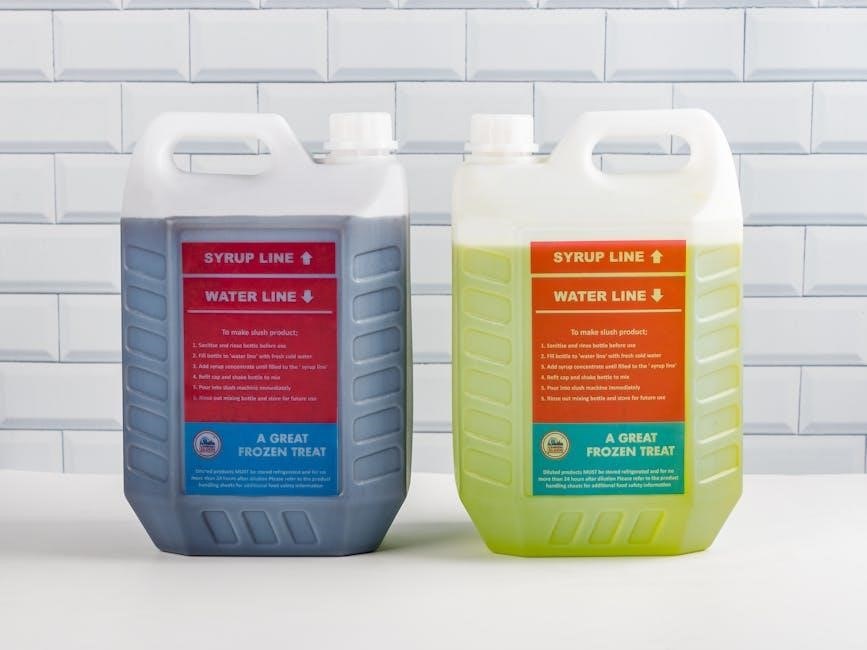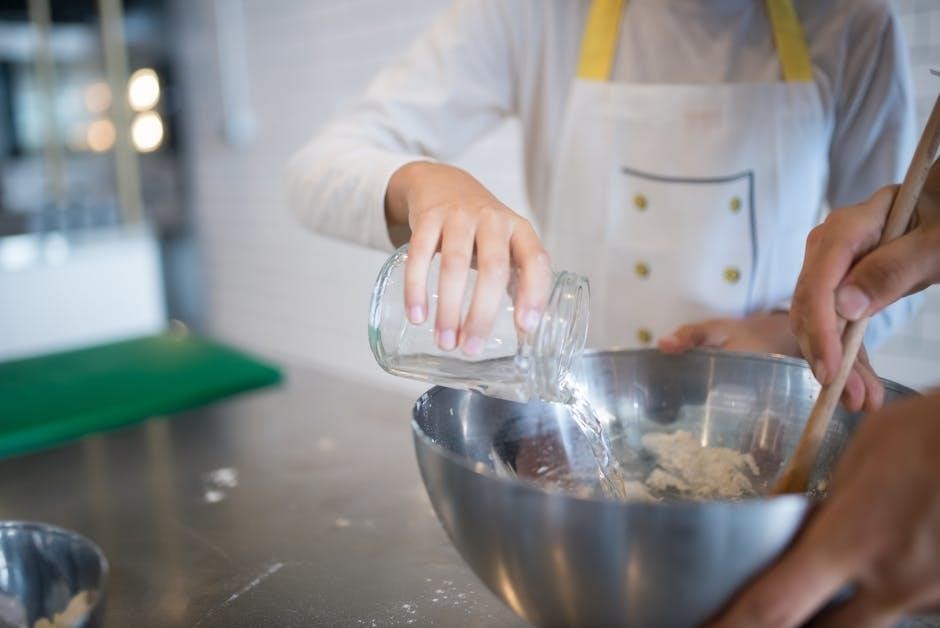Mixing Semaglutide involves adding bacteriostatic water to the powder, creating a solution for injection. A common ratio is 5ml of water for a 5mg vial, yielding 1mg/ml concentration. Proper mixing ensures safe and effective treatment.
1.1 Overview of Semaglutide and Its Uses
Semaglutide is a glucagon-like peptide-1 (GLP-1) receptor agonist used for chronic weight management and glycemic control. It is prescribed for adults with obesity or Type 2 diabetes to help regulate appetite and blood sugar levels. Available in 5mg vials, Semaglutide must be reconstituted with bacteriostatic water before use. Proper mixing ensures the solution is safe and effective for injection, typically administered once weekly. This medication has become a leading treatment option due to its ability to support significant weight loss and improve metabolic health.
Its popularity stems from its efficacy in reducing hunger and increasing feelings of fullness, making it easier for patients to adhere to a healthier lifestyle. Always follow healthcare provider instructions for dosage and administration to maximize benefits and minimize risks.
1.2 Importance of Proper Mixing Techniques
Proper mixing of Semaglutide is essential to ensure the medication’s effectiveness and safety. Incorrect techniques can lead to uneven distribution of the active ingredient, potentially resulting in under- or over-dosing. This could reduce efficacy or increase the risk of side effects. Correct mixing ensures the solution is homogeneous, maintaining the drug’s potency and stability. Properly mixed Semaglutide also prevents contamination, which can compromise the sterility of the solution and pose health risks. Adhering to guidelines ensures consistent dosing and optimal therapeutic outcomes for patients.
Following the recommended mixing procedures is critical for patient safety and the medication’s performance. Always prioritize precision and sterility to achieve the best results.

Understanding the Mixing Process
Understanding the mixing process involves several key steps to ensure safety, precision, and consistency. Proper preparation and execution of each step are crucial for effective results.
2.1 Gather Necessary Supplies
To begin the mixing process, gather all required supplies. These include the semaglutide powder vial, sterile water for injection (diluent), a syringe with a needle for reconstitution, and another syringe without a needle for administration. Additionally, ensure you have alcohol swabs for cleaning the vial tops and a sterile mixing surface or tray. It’s crucial to use only sterile, unused supplies to prevent contamination. Always verify the expiration dates of the diluent and other materials before starting. Avoid using household items, as they may introduce impurities. Proper preparation ensures a safe and effective mixing process.
2.2 Reconstituting the Semaglutide Powder
Reconstitute the semaglutide powder by carefully injecting the sterile water for injection into the vial. Use a syringe with a needle to slowly add the diluent to the powder. Gently swirl the vial to ensure even mixing. Avoid shaking, as it may cause foam formation. Allow the solution to dissolve completely before use. The reconstituted solution should be clear or slightly cloudy. Do not use the solution if it appears gritty or contains visible particles. Always prepare the solution in a sterile environment to maintain safety and efficacy.
2.3 Step-by-Step Mixing Instructions
Begin by preparing the vial and supplies in a clean environment. Remove the vial cap and wipe the rubber stopper with an alcohol swab. Using a syringe, withdraw the recommended volume of sterile water for injection. Slowly inject the water into the vial containing the semaglutide powder. Gently swirl the vial for 30 seconds to mix thoroughly. Allow it to sit for 2-3 minutes to ensure complete dissolution. Inspect the solution for clarity before use. Transfer the reconstituted solution to a sterile syringe for administration. Use a new needle for injection to prevent contamination.

Calculating the Correct Dosage
Calculating the correct dosage involves determining the desired concentration and volume, adjusting for individual patient needs, and adhering to the prescribed 5mg semaglutide standard.
3.1 Determining the Right Concentration
Determining the right concentration for 5mg semaglutide involves balancing the desired dose with the total volume of the solution. Typically, a concentration of 5mg/mL is standard, but this can vary based on patient weight and dosing frequency. Always consult the supplier’s guidelines or a healthcare provider to ensure accuracy. Calculating concentration requires precise measurement of the semaglutide powder and diluent to avoid over- or under-concentration, which can affect efficacy and safety. Proper calculation ensures consistent dosing and optimal therapeutic outcomes.
- Start with the total desired dose (e.g., 5mg).
- Divide by the total volume of solution to achieve the target concentration.
3.2 Measuring the Appropriate Volume
Measuring the appropriate volume is critical for accurate dosing. For 5mg semaglutide, use a 1mL insulin syringe to ensure precision. Calculate the volume based on the concentration and desired dose. Typically, 3mL of diluent is added to the 5mg vial. Gently mix the solution until clear. Avoid shaking, as this can damage the molecule. Always measure carefully to prevent over- or under-dosing, which can affect efficacy and safety. Use a new syringe for each measurement to maintain sterility and accuracy.
- Use a 1mL syringe for precise volume measurement.
- Add the calculated diluent volume slowly to the vial.
3.3 Adjusting for Individual Needs
Adjusting the semaglutide dose for individual needs ensures optimal efficacy and safety. Healthcare providers may customize the concentration or volume based on patient-specific factors, such as weight, glucose levels, or comorbidities. Always consult a healthcare professional before making adjustments. Monitoring blood glucose and weight changes can guide dose modifications. Patients should keep a dosing record and communicate any changes to their provider. Regular follow-ups are crucial to assess treatment response and make necessary adjustments.
- Customize concentration based on patient needs.
- Monitor and adjust doses under professional guidance.

Storage and Handling
Store semaglutide vials in a cool, dry place, away from direct light. Do not freeze. Keep vials in their original packaging until use. Ensure they are out of children’s reach.
4.1 Proper Storage Conditions
Store unopened semaglutide vials in the refrigerator at 2-8°C (36-46°F) to maintain potency. Keep them in their original packaging, protected from light and moisture. Avoid freezing, as this can degrade the medication.
After reconstitution, store the solution in the refrigerator at the same temperature range. Ensure the vial is tightly sealed and label it with the date of mixing. Do not store mixed solution at room temperature or expose it to direct sunlight. Always keep it out of reach of children and pets.
4.2 Shelf Life After Mixing
The mixed semaglutide solution typically has a shelf life of up to 8 weeks when stored properly in the refrigerator at 2-8°C (36-46°F). Always check the solution for visible signs of degradation, such as cloudiness or particulates, before use.
Avoid freezing the mixed solution, as this can compromise its effectiveness. Discard any unused solution after the recommended shelf life to ensure safety and potency. Always verify the expiration date on the original packaging before mixing and administration.
4.3 Disposal of Unused Solution
Dispose of unused semaglutide solution responsibly to minimize environmental impact. Use a sharps container for needles and syringes. For the solution, place it in a sealed container to prevent leakage. Follow local regulations for pharmaceutical waste disposal. Do not discard in drains or regular trash. Proper disposal ensures safety and environmental protection. Always consult local guidelines for specific instructions. This approach helps maintain public health and safety standards while adhering to regulations. Proper disposal is a critical step in handling semaglutide safely and responsibly.

Safety Precautions
Always wear gloves when handling semaglutide to prevent skin exposure. Use sterile supplies to minimize contamination risks. Ensure a clean environment during mixing to maintain safety and efficacy.
5.1 Sterile Technique Essentials
Using sterile technique is critical to prevent contamination. Always wash your hands thoroughly before starting. Wear disposable gloves to avoid direct contact with the solution. Ensure the mixing area is clean and free from debris. Use sterile syringes and needles to maintain asepsis. Open sterile supplies in a clean environment, avoiding direct contact with non-sterile surfaces. Never touch the needle tip or inside of the vial to prevent contamination; Use bacteriostatic water for reconstitution to maintain sterility. If sterility is compromised, discard the solution immediately. Always follow proper aseptic technique to ensure safety and effectiveness.
5.2 Avoiding Contamination
To prevent contamination, ensure all equipment is sterile and handle the vial and syringes with care. Avoid touching the vial’s rubber stopper or the needle tip, as this can introduce bacteria. Use a fresh needle for each injection or mixing step to minimize contamination risk. Clean the injection site with alcohol before inserting the needle. Never leave the mixed solution open to the air for extended periods. If you suspect contamination, discard the solution and start over. Always use bacteriostatic water to maintain sterility and prevent microbial growth in the solution.
5.3 Recognizing Adverse Effects
When mixing and administering 5mg semaglutide, monitor for potential adverse effects such as injection-site reactions, nausea, diarrhea, or vomiting. Some users may experience dizziness, headache, or pancreatitis in rare cases. If severe allergic reactions occur, such as difficulty breathing or swelling, seek immediate medical attention. Report any unusual symptoms to your healthcare provider promptly. Proper preparation and administration can minimize these risks. Always follow the prescribed dosage and consult your provider if side effects persist or worsen. Early recognition ensures timely intervention and prevents complications.

Common Mistakes to Avoid
- Incorrect dilution ratios leading to under- or over-concentration.
- Using the wrong syringe size for precise measurements.
- Not using sterile water for reconstitution.
- Storing mixed solutions improperly.
- Ignoring expiration dates on supplies.
6.1 Over- or Under-Dilution
Over- or under-dilution of Semaglutide can significantly impact its efficacy and safety. Over-dilution may result in a subtherapeutic dose, reducing effectiveness, while under-dilution can lead to increased concentration, causing potential side effects. Ensure precise measurement of diluent volume, as specified in the instructions, to maintain the correct concentration. Double-check calculations to avoid errors. Always use the recommended diluent and follow the manufacturer’s guidelines for accurate mixing. Proper technique and attention to detail are crucial to achieving the correct formulation for safe and effective treatment.
6.2 Incorrect Syringe Usage
Using the wrong syringe or improper technique can lead to dosing errors. Always use a syringe specifically designed for Semaglutide, as other syringes may not measure accurately. Avoid using insulin syringes, as they are calibrated differently. Ensure the syringe size matches the prescribed dose to prevent under- or over-administration. Never reuse syringes or needles, as this can introduce contamination or cause blockages. Always replace the needle after mixing to prevent leakage or inaccurate dosing. Proper syringe handling is critical for maintaining the integrity and effectiveness of the Semaglutide solution.
6.3 Improper Storage Practices
Improper storage can compromise the effectiveness and safety of Semaglutide. Avoid exposing the mixed solution to direct sunlight or high temperatures, as this can degrade the active ingredient. Never store the solution in areas prone to moisture or humidity. Failing to refrigerate the mixed solution within the recommended timeframe can lead to instability. Additionally, using expired diluents or storing the mixture beyond its shelf life can reduce potency. Always label the solution with the date of mixing and store it according to the manufacturer’s guidelines to ensure optimal results and patient safety.

Advanced Mixing Strategies
Optimize mixing techniques for consistent results, ensuring precise measurements and high-quality supplies to minimize errors and enhance solution stability.
7.1 Customizing Concentration Levels
Customizing concentration levels for 5mg semaglutide involves adjusting the diluent volume to achieve the desired strength. This allows for personalized dosing, ensuring effectiveness while minimizing side effects. Higher concentrations can reduce injection volume, making administration more convenient. However, precise calculation is critical to avoid over- or under-concentration. Always use sterile water or the provided diluent, and consult a healthcare provider to determine the optimal concentration for individual needs. Proper adjustment ensures safety and efficacy, tailored to patient-specific requirements.
Key: Maintain accurate measurements to preserve drug stability and therapeutic impact.
7.2 Using Different Diluents
When mixing 5mg semaglutide, the choice of diluent is crucial for stability and efficacy. While sterile water is the standard diluent, alternatives like bacteriostatic water or saline may be considered under medical guidance. Each diluent affects the solution’s properties, such as pH and osmolality. Ensure compatibility with semaglutide to prevent degradation or precipitation. Always follow manufacturer guidelines or healthcare provider recommendations. Using unauthorized diluents can compromise the drug’s integrity and safety. Proper selection and use of diluents are essential for optimal therapeutic outcomes and patient safety.
Remember: Consult a healthcare professional before deviating from standard diluents.
7.3 Multiple Vial Management
Managing multiple vials of 5mg semaglutide requires careful organization to ensure accuracy and safety. Label each vial with the date of reconstitution and concentration to avoid confusion. Store vials in a dedicated, secure location, such as a refrigerator, to maintain stability. Use a log to track the volume and dosage administered from each vial. Always use separate syringes and needles for each vial to prevent cross-contamination. Properly discard any expired or unused solution according to guidelines.
Tip: Consult a healthcare provider for personalized advice on managing multiple vials effectively.

Troubleshooting Common Issues
Addressing issues like cloudiness or sediment in the solution, which may indicate improper mixing or contamination. Inspect vials for cracks or damage before use to ensure safety.
8.1 Solubility Problems

Solubility issues with semaglutide can occur if the powder does not dissolve properly in the diluent. This may result in a cloudy or precipitated solution, which can affect dosing accuracy and drug efficacy. To address this, ensure the diluent is at room temperature and gently swirl the vial rather than shaking it vigorously. If particles remain undissolved, allow the mixture to sit for a few minutes before gently swirling again. Always use the recommended diluent to maintain stability and solubility. If the issue persists, consult the manufacturer’s guidelines or a healthcare professional for assistance.
8.2 Leakage or Cracking of Vials
Leakage or cracking of Semaglutide vials can compromise the medication’s integrity. Always inspect vials for damage before use. If a vial is cracked, handle it carefully to avoid injury. For leaks, ensure the area is sterile and wear gloves. Contact a healthcare provider for a replacement. Store vials in a protective case to prevent accidental damage. Never use a vial that has been dropped or cracked, as this may affect the drug’s stability and potency. Proper handling and storage are crucial to maintain the effectiveness of the medication.
8.3 Inconsistent Dosing
Inconsistent dosing can occur due to improper mixing, inaccurate measurements, or uneven distribution of the semaglutide solution. This may lead to fluctuating medication levels, affecting treatment efficacy. To address this, ensure precise measurement of diluent and powder, mix thoroughly, and use a syringe with appropriate volume markings. Always draw the solution from the same vial consistently and store it correctly to maintain uniform concentration. Regularly checking the solution’s appearance and consulting a healthcare provider if issues persist can help resolve inconsistent dosing challenges.

Patient Education and Resources
Patient education is crucial for safe and effective semaglutide use. Provide clear instructions, diagrams, and troubleshooting tips in easy-to-understand formats. Include access to online tutorials and videos demonstrating proper mixing techniques. Encourage patients to consult healthcare providers for personalized guidance and support.
9.1 Educational Materials for Patients
Providing clear educational materials is essential for patients to understand proper semaglutide mixing techniques. These materials should include step-by-step guides, diagrams, and troubleshooting tips. Patients benefit from printed instructions, videos, or interactive tutorials to reinforce proper methods. Emphasize the importance of sterile technique, accurate dosing, and storage guidelines. Additionally, materials should address common questions and concerns, such as handling missed doses or recognizing adverse effects. Ensuring patients have accessible resources helps improve adherence and safety when mixing 5mg semaglutide.
9.2 Online Tutorials and Videos
Online tutorials and videos provide visual guidance for mixing semaglutide, making the process clearer for beginners. Platforms like YouTube and pharmaceutical websites often host step-by-step videos demonstrating proper techniques. These resources highlight key steps, such as handling the vial, adding the diluent, and ensuring even distribution. Many videos are created by healthcare professionals, offering expert advice. They also address common mistakes, like improper mixing or contamination risks. Patients can pause, rewind, and rewatch segments, enhancing understanding. These tools are especially helpful for those who prefer visual learning or need reinforcement beyond written instructions.
9.3 Healthcare Provider Guidance
Healthcare providers play a crucial role in ensuring patients understand and correctly follow 5mg semaglutide mixing instructions. They should provide personalized guidance, addressing any concerns or questions patients may have. Providers should emphasize the importance of sterile technique and proper dosing to avoid complications. Regular follow-ups are recommended to monitor adherence and address potential issues. Additionally, healthcare providers should be prepared to troubleshoot common mixing errors and offer tailored advice for patients with unique needs. Clear communication and ongoing support are essential for successful treatment outcomes.
Properly mixing 5mg semaglutide ensures safe and effective use. Always follow sterile techniques and consult a guide for precise instructions. For next steps, review the process regularly and seek healthcare advice for personalized guidance. Continuous learning and adherence to protocols are key for optimal results and patient safety.
10.1 Summary of Key Points
Properly mixing 5mg semaglutide requires careful attention to sterile technique, accurate measurements, and adherence to storage guidelines. Always gather the correct supplies, including the vial, diluent, and syringes. Reconstitution involves slowly adding the diluent to the powder, avoiding bubbles. Store the mixed solution in the refrigerator at 2-8°C and use within the recommended shelf life. Consistency in dosing is crucial for therapeutic effectiveness. Avoid common mistakes like over- or under-dilution and improper storage. Following these steps ensures safe and effective use of semaglutide.
10.2 Encouragement for Further Learning
Continuing education is key to mastering semaglutide mixing. Explore online tutorials, webinars, and forums to deepen your understanding. Staying updated on best practices ensures safe and effective preparation. Engage with healthcare professionals for personalized insights and guidance. Sharing knowledge with peers can also enhance your skills. Remember, consistent learning leads to confidence and proficiency in handling semaglutide. Dedicate time to refine your technique and stay informed about advancements in diabetes management. Your commitment to learning will contribute to better patient outcomes and improved treatment success.
10.3 Final Tips for Successful Mixing
To ensure optimal results when mixing 5mg semaglutide, always follow the manufacturer’s instructions precisely. Use sterile equipment and maintain a clean environment to prevent contamination. Measure the diluent accurately to achieve the correct concentration. Avoid vigorous shaking, as this can damage the molecule. Store the mixed solution in the refrigerator at 2-8°C and use it within the recommended timeframe. If unsure, consult a healthcare professional for guidance. Consistency and attention to detail are key to successful mixing and safe administration.
